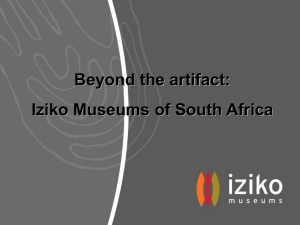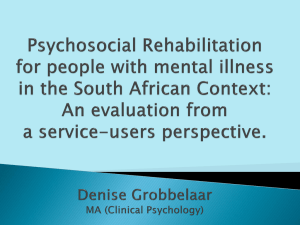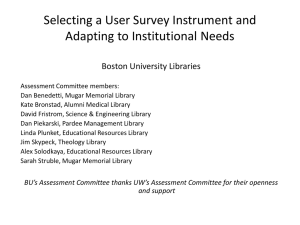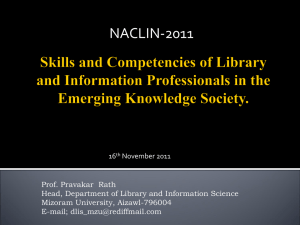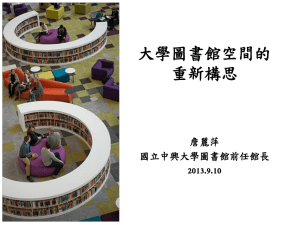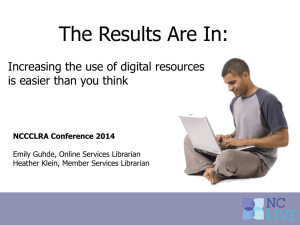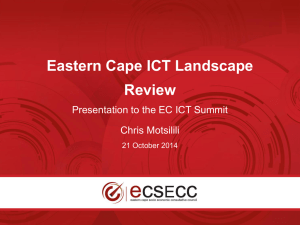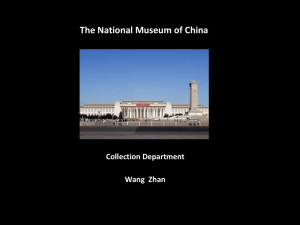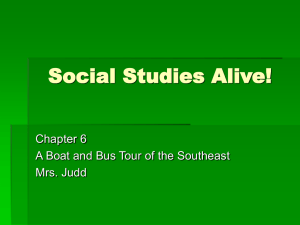Library Marketing Efforts in the Eastern Cape Paper presented by
advertisement
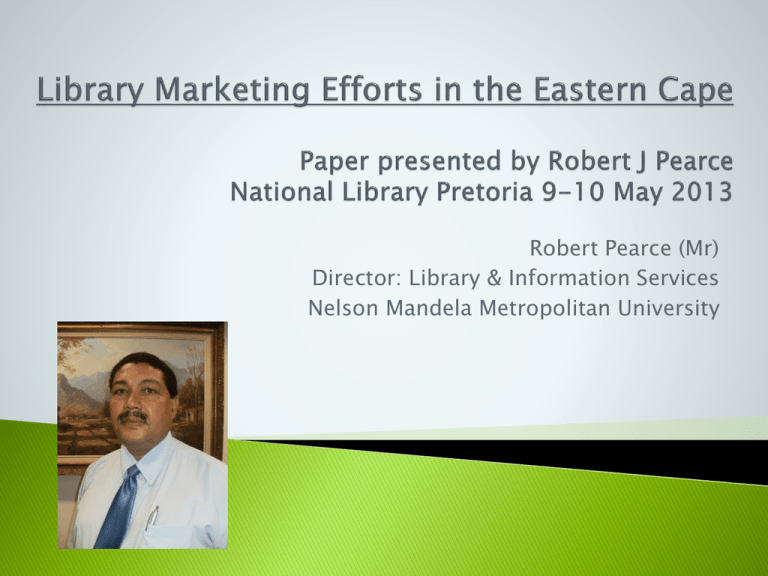
Robert Pearce (Mr) Director: Library & Information Services Nelson Mandela Metropolitan University To the Organizers Thanks for the Invitation When I was requested by the Organizers to talk about Public Library Marketing Efforts in the Eastern Cape, I decided to widen the topic and include all types of Libraries, namely Public, University, Special and School Libraries. I wrote to the Librarians thus: Dear Colleagues Do you have any information about Marketing efforts in your Libraries, please forward it to me. Short Paradigm: Eastern Cape as a Developing Society Eastern Cape Libraries: Public and Community Libraries Academic and Special Libraries, SA Library for the Blind in Grahamstown. Library Marketing Strategies and Milestone Plans Marketing Budgets Any other information Could I please have this information by 17 April 2013 enabling me to write the Paper? Regards Robert Only One Public Library one University Library (NMMU Library and Information Services-obviously) responded. I decided to look at the Eastern Cape Libraries websites enable me to establish how they Market their Libraries. More on this later Introduction Developing v/s Developed Societies and the Library and Information Services Needs of the Inhabitants Eastern Cape as a Developing Society Marketing of Libraries Aspects of Marketing environment in Developing Societies 21st Century Marketing Strategies and Techniques Eastern Cape Libraries and Marketing Nelson Mandela Bay Metropolitan Umtata Bisho Fort Hare University Walter Sisulu University South African Library for the Blind Eastern Cape Museums Eastern Cape Provincial Government Nelson Mandela Metropolitan University LIASA Eastern Cape Marketing efforts Way Forward Bibliography Strategic Plan PAGLIC Examples of Online Marketing: LIASA Limpopo More 21st Century Marketing Strategies: 3rd Industry Symposium Developing societies (also referred to as developing communities, developing countries, less developed countries, rural societies and Third World countries) usually have many of the following characteristics: The economic conditions (such as income and economic growth) and the infrastructure (transport, housing and hospitals) are poor; the agricultural population is large; the social conditions (for example human nutrition) are poor; infant mortality is high; literacy is low; technological skills are low but technological dependence is high. There is a high population growth. Most of the inhabitants are peasants; the ethnic/cultural variety is wide; and the behaviour is traditional. On the political front, the political stability is low and the government is authoritarian or military (Barke & O'Hare 1991:5). Kotze (1980:22), Van Zijl (1987:142), Johnstone (1988:45-54) and Bristow (1992:72) state the following: educational; economical; legal; political; cultural; social; psychological; spiritual; physiological (food); housing; health; literacy; libraries and information centres; networks; infrastructure; and ways and means to eradicate poverty, hunger, disease, unemployment and illiteracy. The information needs of the inhabitants can be: needs for development and for functioning in a developed world (Tsebe 1985:125); needs related to personal existence; survival information needs; helping information needs (ie information that inhabitants need to exercise civic and political rights); leisure information; and information which would help them to adapt to social and cultural change (Kaniki 1995:15). In contrast, developed societies (also called urban settlements, westernized countries, more developed countries and First World countries) generally have the following characteristics as stated by Barke & O'Hare (1991:5): The economic conditions and infrastructure are good; the agricultural population is small; the social conditions are good; infant mortality is low; literacy is high; technological skills are high and technological dependence low. There is a low rate of population growth. Most of the inhabitants are living in industrial areas; the ethnic/cultural variety is small, and the behaviour is modern. On the political front, the political stability is high and the government is democratic or socialist The needs of the inhabitants of developed societies are mostly similar to those of the inhabitants of developing societies if one compares the following needs as stated by Jordaan, Jordaan and Nieuwoudt (1979:791), Kotze (1980:22) and Van Zijl (1987:142). These needs include: physiological needs; psychological needs; spiritual needs; security needs; the need to belong and be accepted; self-esteem needs; educational needs; the need for self-actualization; economic needs; cultural and recreational needs; and the need for information. According to Hodowanec (1979:219) the information needs of the economically advantaged (i.e. inhabitants of developed societies) range from "leisure interest, through factual type of information required to meet everyday needs, to occupational and/or research information needs Some articles: National survey casts East Cape in dismal light, 04 May 2012 Brian Hayward THE Eastern Cape has received prominent mention in the latest countrywide survey of households, released yesterday by Statistics SA – but for all the wrong reasons. According to the Stats SA General Household Survey 2011, conducted from July to September, the province has the: Most grant beneficiaries; Most households without flush toilets; Worst piped-water access; Highest number of children not attending school because "education is useless”; Most pupils who receive hidings at school; Second-highest number of households relying solely on social grants for survival; and Second-highest number of households without a phone. The province has the dubious distinction of having the highest incidence countrywide of corporal punishment at its schools, indicated by pupils surveyed at home by researchers. ◦ "Corporal punishment was most common in the Eastern Cape [30.2%], KwaZulu-Natal [22.5%] and Free State [22.1%], and least likely to occur in the Western Cape where it was reported for only 3.7% of learners,” the report said. The Eastern Cape had the second-highest number of pupils attending no-fee schools (71.8%), after Limpopo (89.7%). The percentage of pupils who reported they paid no tuition fees had increased from 0.7% in 2002 to 55.6% last year. Of children in the province not attending any educational institution, 18.3% of those surveyed said the main reason was that "education is useless”. This contrasted with 2% of Limpopo children and 6.9% of children countrywide who gave this as a reason. The Eastern Cape also had the highest number of grant beneficiaries per household. "Individuals in the Eastern Cape [38.5%], Limpopo [38.1%] and Northern Cape [37.7%] are most likely to be grant beneficiaries,” the report said. "More than half of households in Limpopo [58.9%], Eastern Cape [56.7%] and Northern Cape [55.7%] received at least one grant compared to 28.5% of households in Gauteng and 37% in the Western Cape.” The Eastern Cape came out tops for poor access to water. "Although 89.5% of South African households had access to piped water in 2011, only 74.8% of Eastern Cape households enjoyed such access. "This does, however, represent a substantial improvement over 2002 when only 56.8% of households in this province had access to piped water.” The province was also ahead for the number of households without flush toilets, with 17% of households surveyed relying on the bucket system. The national average was 5.7%. Eastern Cape households were the second most likely to survive solely off social grants (57.3%), after Limpopo (59.1%). In comparison, more than two-thirds of households surveyed in the Western Cape and Gauteng lived off salaries rather than grants. Telecommunications were a problem, the report stated, with 16% of Eastern Cape households unlikely to have access to either cellular or landline services – second after Limpopo (19.3%) and an above the national average of 9%. The province also received mention for still having a high number of households that relied on wood and paraffin for cooking (36%), while the national average of electrified households had risen from 76.8% in 2002 to 82.7%. Rhodes University’s Public Service Accountability Monitor (PSAM) said it was not surprised at the findings. "They are further evidence of a province mired in political turmoil and factionalism, which severely undermines service delivery and the constitutional rights of the province’s people,” PSAM media and advocacy head Derek Luyt said. Traditional marketing methods Marketing is the underlying philosophy that an organization should be customer-orientated and that its staff should work together to achieve this focus (Adcock et al 1993:367). Kotler and Armstrong (1989:5) state that: [m]arketing is a social managerial process by which individuals and groups obtain what they need and want through creating and exchanging products and value with others. Marketing functions include activities such as advertising, sales, merchandising, research, product development, distribution and customer services (Adcock et al 1993:9). Van Dalsen (1986:55) proposed that marketing should be used as a strategy by libraries to improve awareness of their services amongst academics. According to Van Dalsen (1986:55), the main aim of the marketing process is to achieve the aims of the organization. Since a university library is a non-profit organization, concepts such as "sales" and "merchandising" are unlikely to be included in its marketing philosophy. With regard to marketing strategies applied at university libraries the following are mostly used: promotion; library displays; user education and current awareness services which, according to Thompson (1977:119), are essential in an academic library. advertising in newspapers or magazines; publicizing on television, radio and Internet Visual merchandising (an umbrella term embracing library displays and exhibitions) is designed to draw attention to the library's products and services (Dalton 1989:188). The library can have permanent exhibitions in its foyer or exhibition rooms to promote the library or highlight certain of its sections and services. Visual merchandising can be organized by the library or by organizations not affiliated to the library. User education (also referred to as library instruction, reader instruction or library orientation [Prytherch 1995: 665]) includes any type of library skills or awareness programmes, for example: audio-visual programmes on the library; library tours; provision of literature on the library's services and activities; visits to academic departments; and informal lectures on the library. Libraries use current awareness services to keep their users up-todate with the latest information in their subject fields. Some examples of current awareness services are: selective dissemination of information, circulation of current issues of periodicals, electronic transfer of contents pages of periodicals, alerting bulletins, lists of new acquisitions, library promotion and displays and distribution of publishers' catalogues. As alluded to under the characteristics of Developing Societies where: literacy is low; technological skills are low but technological dependence is high, and networks and infrastructure are mostly non-existent This is the environment that Libraries in Developing Societies are faced with daily which will severely influence their marketing efforts Also electricity and Bandwidth Shortages will have an influence on the use of 21st Century Technology -Valuable Book-Found on GOOGLE Books St. Martin's Press, 1984 - 259 pages. In this unique collection Kindra has assembled original articles on the role of marketing in development Combining classic, traditional marketing methods with newer techniques made possible by the Internet and social networking media can help companies tailor their marketing strategies for success in today’s world. By Heather Clancy http://searchitchannel.techtarget.com/feature/Channelmarketing-strategy-Seven-steps-for-21st-Century-success When it comes to your channel marketing strategy, the days of relying solely on word of mouth are over. The rise of social networks and sophisticated digital marketing platforms has rewritten the channel marketing strategy rules, even for technology solution providers that still haven’t created a formal marketing plan. Increasingly, businesses are shaping their opinions about their various technology options long before an IT services firm ever makes contact with a decision-maker. Step 1 Structuring your strategy Step 2 Understanding your ecosystems Step 3 Defining your future Step 4 Targeting Step 5 Proposition Step 6 Getting new customers Step 7 Keeping customers engaged and loyal Social media marketing refers to the process of gaining website traffic or attention through social media sites.[1][2] Social media marketing programs usually center on efforts to create content that attracts attention and encourages readers to share it with their social networks. A corporate message spreads from user to user and presumably resonates because it appears to come from a trusted, third-party source, as opposed to the brand or company itself.[3] Hence, this form of marketing is driven by word-of-mouth, meaning it results in earned media rather than paid media.[4] Social media is a platform that is easily accessible to anyone with internet access. Increased communication for organizations fosters brand awareness and often, improved customer service. Additionally, social media serves as a relatively inexpensive platform for organizations to implement marketing campaigns. Using Social Media and Traditional Methods Mobile phones and other Mobile devices as Marketing tools (Cellphones; SMS messages as reminders that you have Library Fines; Books are late; books have arrived in Library=Airpac?) Facebook Twitter SMS Online LIS Webpages Radio Television Newspapers Magazines Posters Flyers Bill Boards (used by Companies and promotion of sports events and music festivals Undergraduate advertising campaigns Two undergraduate advertising campaigns were run during 2012, promoting respectively the Open Day and the closing date for undergraduate applications. The two campaigns were linked by the shared idea and theme of NMMU as the ideal place to realise career dreams. The theme also set the tone for advertisements and other forms of marketing communication media. Although these campaigns targeted specific audiences aiming either to inform, remind or to call to action, they simultaneously increased brand awareness. The media mix consisted of a variety of communication channels, including print media (newspapers and magazines), broadcast media (radio), electronic media (websites, web banners and video productions), social media platforms (Twitter and Facebook) and display media (billboards, posters, flyers and shopping mall exhibitions in PE, East London and George). The campaigns were also supported by competitions and information sessions to the broader public. The Open Day campaign promoted the event as the ideal opportunity for prospective students to discover all the various study options at NMMU The annual undergraduate campaign conveyed a strong message to apply in time before the closing date of 1 August to ensure admittance to the study programme of choice. The campaign was followed by a mini advertising campaign which served as reminder of the late closing date on 5 December. Student recruitment advertising included the placement of advertisements, advertorials (additional editorial content) and articles in the following media. Frequency of placement was obviously dictated by costs and available budget. Newspaper advertising: The following newspapers were included in the media mix during advertising campaigns. Eastern Cape: The PE Herald – circulation 21 600 Die Oos-Kaap Burger Jip (weekly youth supplement) – circulation 16 500 Weekend Post (major regional weekend newspaper in EC – circulation 24 510) Western Cape: Die Wes-Kaap Burger – circulation 45 000 (western regions of province) Cape Times (ad in bursary and scholarship supplement) Kwa-Zulu Natal The Mercury (Kwa-Zulu Natal) – leading newspaper in province; circulation of 35 000 The Witness (Pietermaritzburg and inlands of KZN) – circulation 20000 Community papers: Eastern Cape: PE Express (Port Elizabeth) – free newspaper; circulation of 90 000 PE Express Indaba (Port Elizabeth townships) – free newspaper; circulation of 40 000 Zithethlele (Port Elizabeth) – free English/Xhosa community newspaper handdelivered to 20 000 commuters fortnightly in Nelson Mandela Bay) UD News (Uitenhage, Despatch, Sundays River Valley) – free newspaper; circulation 30 000 Mthatha Fever (Port St Johns, Mthatha, Libode, Ngqeleni, Tsolo, Qumbu and Mt Frere) – circulation 60 000; news in Xhosa and English Uvo Lwethu Fever (Bizana, Flagstaff, Lusikisiki, Ntabankulu, Mount Ayliff, Mount Frere and Port St Johns – circulation 20 000; news in Xhosa and English Isolomzi Fever (Cala, Dutywa, Butterworth, Centani, Elliotdale,Ngcobo, Tsomo, Nqamakwe, Willowvale, Cofimvaba and Elliot – circulation 20 000; news predominantly in Xhosa Note: Fever community newspapers are also Media24 community papers, similar to PE Express and UD News. Go & Express (East London, Beacon Bay and Gonubie) – circulation 30700 Community papers: Western Cape: Knysna/Plett Herald – circulation 4 300 George Herald (weekly local community newspaper distributed in the Garden Route area; circulation19 000 per week. Mosselbay Advertiser (weekly community newspaper covering Mosselbay area, Dana Baai, Great Brak River, Hartenbos, George and Albertinia – circulation 8 274 The/Die Hoorn (weekly newspaper in Oudtshoorn) Limpopo: Limpopo Mirror – targeting Thohoyandou, Louis Trichardt, Sibasa, Tshakhuma, Shayandima, Elim, Musina, Malamulele, Levubu and Giyani – circulation 10 860 Kwa-Zulu Natal: South Coast Herald – targeting Port Shepstone area (news in English and Zulu) – circulation 18 500 Careers Unlimited (approved by the Department of Basic Education as a teachers resource guide and is use extensively by teachers as a textbook during Life Orientation classes. Distributed to all high schools throughout SA by the various DoE district offices) The Bursary Register (This booklet provides everything you need to know about bursaries, scholarships and loans in South Africa.) Science, Engineering & Technology Careers (free placement for Science and EBEIT faculty) CareersSA (publication distributed at all universities’ graduate careers fairs) SA Schools Collection (printed and on-line educational guide showcasing top SA schools) Independent Education (official magazine of Independent Schools Association of South Africa) Future Guide 2013 (Rocking Future Careers Road Show supplement) Fly Magazine Port Elizabeth (popular printed and on-line teen magazine in Port Elizabeth) High School Buzz (on-line teen magazine) Due to costs involved the use of broadcast media, such as radio, was limited to the two undergraduate advertising campaigns and a few interviews. Open Day advertising campaign: Algoa FM Footprint: 846 000 listeners in Eastern Cape; 20 placements between 30 April to11 May. Umhlobo Wenene Footprint: 4.8 million listeners in seven provinces, including Eastern Cape, Western Cape, Gauteng, KZN, Free State, North West, Northern Cape and Mpumalanga; 6 Live reads between 30 April and 5 May. Eden FM Community radio station in the Klein Karoo / 200 000 listeners; 12 live reads and on-campus live broadcast during Open Day event. Undergraduate closing date campaign: 5FM 54 ad slots of 30 seconds each. Broadcast over three weeks. Eden FM Bi-weekly interviews. Monthly interviews on RSG Landbou (George Campus) Open Day campaign adverts on NMMU website Dream-starter website to promote closing date campaign Communication via NMMU Facebook and Twitter and YouTube channel Examples: NMMU LIS Website Focus area E-research – to establish an effective online research environment that supports research activity in the university and encourages collaborative research, data archiving and data sharing within NMMU and external partners Online Catalogue Home Contact us E-Forms Faculty librarians FAQ General information Information resources Library hours LIS e-Resources Seminar Services Suggestions and comments Training Training sessions Mr Robert Pearce and Dr Mamphela Ramphele at the launch of the Northern Areas People Development Initiative ("NAPDI") Mr Robert Pearce and Dr Mamphela Ramphele at the launch of the Northern Areas People Development Initiative ("NAPDI") Dr Ramphele is the former Vice-Chancellor of the University of Cape Town and currently an Activist for Social Change and Development. She was the guest speaker at the launch. NMMU VC, Professor Swartz, is a patron of NAPDI NAPDI's main objectives are To be A Voice within the Community, An Enabler of community empowerment, Mobilizer of people and resources, A Catalyst for change. It’s values are based on a civil society movement promoting volunteerism in a culturally diverse and inclusive community that makes a difference. Looking for How to... Useful links Books/Journals Login from off-campus My library record Accredited journals Access WiFi hotspot InfoWise Free trial databases Apply reference styles New books NMMU theses & dissertations Search accross databases Google Scholar WorldCat Old exam papers Reference Manager: EndNote now available Nelson Mandela Metropolitan University Telephone: 041-504 1111 | Fax: 041-504 2574 / 2731 E-mail: info@nmmu.ac.za PO Box 77000 | Nelson Mandela Metropolitan University Contact usPort Elizabeth | 6031 | South Africa News & Events Staff mail | Student mail Staff portal | Student portal BEE & Tax certificates | PAIA | ISPA WCMS © NMMU 2005-2013 A-Z Index NMMU site map Faculty Librarian Blogs as contacts with researchers and academics, students and academics Information literacies Skills training online through Infowise Faculty Librarians General information FAQ How to login from off-campus Library hours Mission/Vision Rules and Code of Conduct Service Level Agreement Suggestions and comments Information Resources Databases Free trial databases International repositories Accredited journals Library catalogue New books Newspapers Rhodes University Library Artillery Road Grahamstown, Eastern Cape, 6140 South Africa +27466038436; library ru.ac.za Web site: http://www.ru.ac.za/library/ Catalog URL: http://opac.seals.ac.za/search~S2 Elsewhere: lib-web-cats (Library Technology Guides) Description: Rhodes University Library is an Academic library. This library is affiliated with Rhodes University. The collection of the library contains 400,000 volumes. The library circulates 144,000 items per year. The library serves a population of 7,000 students, faculty and staff. Added by: Discus. Contacted: Not contacted. Venue ID: 70450 University of Fort Hare - Contact Details University of Fort Hare Private Bag X1314 Alice, 5700. Eastern Cape, South Africa. Tel: +27 40 602 2256 ... wvw.ufh.ac.za/Cached You +1'd this publicly. Undo The University of Fort Hare is hosting a Book Launch, Prickly Pear: A social History of a plant in the Eastern Cape, on Wednesday 28 March 2012, at the Alice ... Walter Sisulu University for Technology and Science www.wsu.ac.za/.../WSU_general%20_prospectus_INSIDE.pdfSimilar File Format: PDF/Adobe Acrobat - Quick View Walter Sisulu University (WSU) was established on 1 July, 2005 through the merger of the former Border Technikon, Eastern Cape Technikon and the University of Transkei. WSU is a ..... Library & Information Services. Ms W Danster - M ... www.salb.org.za/Cached - Similar South African Library for the Blind (SALB) The South African Library for the Blind (SALB) contributes to the quality of life of printhandicapped people encouraging independence through access to ... Contact us About Us address details Postal Address PO Box 115 Grahamstown Eastern ... history The Library serves a specific constituency and ... Library Catalogue Search National Book Week Welcome to The South African Library for the Blind Online ... National Book Week: The SALB sponsored the Nkosinathi ... Services Documents library services The Library services consist of Circulation ... New mini library for the blind ... SERVICES: Reading for leisure, information and education Reference and research services Internet and email services Photocopy and fax facilities Outreach and house bound services Activities for children Programmes and projects MARKETING EFFORTS Nelson Mandela Bay Metropolitan Municipality The NMBMM do not have a marketing budget, and since we did not have one we have recently developed a library promotional DVD that talks to all the services offered by our libraries. The DVD has been circulated at clinics and Municipal pay points and at all libraries. They play it on their TV screens daily for people to know what we offer. It is through our programmes and activities that we advertise ourselves in community radio stations and Television of which we contact them through our municipal communication department, the little bit of funding we have is used for programmes where each library creates a programme for their community. If funds were available It would actually be good to have these programmes culminating into a one big event that would market libraries. We recently embraced the National Book Week event that will be taking place for the second time in the City. Libraries are participating in the National Book Week initiative together with South African Book Development Council to provide a platform for the Nelson Mandela Bay community to promote and showcase their creative ability and also to promote access and use of reading material in a way marketing and bringing awareness to our libraries. East London 5200 South Africa Tel. 043 705 9111 BUFFALO CITY METROPOLITAN MUNICIPALITY A City growing with you Library East London Central Library Telephone (043) 722-4991 Vincent Library (043) 726-2534 Cambridge Library (043) 727-9000 Greenfields Library (043) 736-1700 West Bank Library (043) 731-1547 Parkside Library (043) 722-8941 Buffalo Flats Library (043) 733-8020 Gompo Library (043) 733-1116 Gonubie Library (043) 705-9737 Beacon Bay Library (043) 748-1451 Braelyn Library (043) 741-2031 Mdantsane Library (043) 760-0800 Kidds Beach Library (043) 781-1935 King Williams Town Library (043) 642-3391 Breidbach Library (043) 644-1122 Schomville Library (043) 604-8399 Berlin Library (043) 685-2155 Mobile libraries (043) 722-4991 Umtata Public Library Owen St Umtata, 5100 MAP IT South Africa Voice: +27 47 501 4197 South Africa • Eastern Cape • Mthatha (Umtata) Directory :: Home Page / Index Mthatha (Umtata) Local Community Organisations • Library Services • Local Council - Municipality • NGO's & Community Volunteering • Schools - Pre-Primary to High School • Sports and Social Clubs • Universities and Technical Colleges Mthatha (Umtata) Library Services EASTERN CAPE MUSEUM LIBRARY SERVICES East London Museum Library MONDAY, SEPTEMBER 18, 2006 Duncan Village in the 1980's The library has received images of Duncan Village in the 1980's from the Museum Human Scientist, Mr. Zuko Blauw. The images are by courtesy of The Daily Dispatch. posted by East London Museum Library @ 6:13 AM 0 comments TUESDAY, NOVEMBER 08, 2005 From our files: A brief history of East London Museum The East London Museum was established in 1921 when the Mayor of East London, Captain Neale, called a meeting on July 19 to discuss the establishment of a museum in the city. A Museum Society was established. Dr. R.J. Rattray, headmaster of Selborne College and a trained botanist, was appointed as President of the Society. The Society collected money and specimens and ran a one-room museum in temporary quarters above the X.L. Tea Rooms in Oxford Street. In 1925 the Society was granted land on the Selborne Estate by the East London Municipality. The museum was officially opened on 26 September 1931. In December of that year, Miss Marjorie Courtenay-Latimer was appointed as Curator of the museum (the name of this position was changed to Director in 1945). The museum remained a one-woman museum (except for cleaners and a gardener) until 1953, when a typist-bookkeeper was appointed. By the end of the Second World War in 1945, the museum was filled with collections and displays. A new site was obtained and the nucleus of the present museum was officially opened to the public on 28 November 1950. Further extensions have subsequently been added in 1963, 1967, 1982 and 2005. Highlights of the museum's activities: The excavation of a large fossil reptile skull and skeleton: Kannemeyeria Simocephalus formerly known as Kannemeyeria Wilsonii near Tarkastad between 1934 and 1936; The discovery of the coelancanth in 1938; Trace-fossil footprints found in the sandstone rock-face near Nahoon Point, in 1964. Core holdings: Natural history collections, which includes Mammalia, Malacology, Reptilia, Ornithology, Pisces and Botany. Cultural and human history collections, which includes beadwork, German Settlers, British Settlers, The Southern Nguni and the San-Bushman. Maritime history, which includes the exploration voyages, shipwrecks, salvaging and East London Harbour. posted by East London Museum Library @ 10:29 PM 7 comments MONDAY, OCTOBER 17, 2005 MONDAY, APRIL 11, 2005 Gamely House Wonderful to see the fine article written by Henrik Dreboldt on Gately House in the Saturday Dispatch of 9th April 2005. According to the article Gately House is one of East London's best kept secrets. The head of East London Museum, Mr. Mcebisi Magadla, is not satisfied with the number of visitors to Gately House. Mr. Magadla indeed would like to see more people visit Gately House. The article further says that the public has'nt entirely forgotten Gately House. Many students still contact the museum to get photos and to study the library's records on the house. Thank you Henrik and Daily Dispatch for bringing this historical landmark under the attention of the public. posted by East London Museum Library @ 2:17 AM 0 comments Google Search 4 April 2013 Times (6/6/2011) reports that only 21% of public schools have libraries, according to the Department of Basic Education. Limpopo, the Eastern Cape and Mpumalanga, the provinces performed worst in the 2010 matric exams, have the fewest libraries in relation to the number of schools. May figures said only 7.5% of Limpopo's 3924 schools, 9.7% of the Eastern Cape's 5676 schools and 17.3% of Mpumalanga's 1868 schools had libraries. In the North West 321 of 1674 schools have libraries. More than half the schools in Gauteng - 1191 of 2031 - and the Western Cape - 775 of 1464 - have libraries. These figures are "scandalous", according to Prof Genevieve Hart, of the University of the Western Cape's department of Library and Information Science. POSTED BY INGRID THOMSON, 06/06,2011 @ 08:28 Quick Search Catalogue My library ◦ ◦ ◦ ◦ ◦ Personal data Documents on loan Documents on hold Renewals Alerting Service New in your Library's Collection About 30 Libraries EASTERN CAPE BRANCH Walter Sisulu University Private Bag X3182 BUTTERWORTH 4960 047 401 6277 stcingo@hotmail.com PAGLIC Eastern Cape No marketing plan *Strategic Plan-2013 Marketing & Communication Develop a marketing and communication plan Strengthen existing marketing and communication channels Draw communication procedures manual Marketing activities for the whole year Marketing brochures Procedures for communication LIASA LIMPOPO BRANCH FIRST QUARTER NEWSLETTER – APRIL 2013 liasaonline@list.liasa.org.za on behalf of; Maropene Ramabina Maropene.Ramabina@univen.ac.za 1ST QUARTER 2013 NEWSLETTERS Editor’s comment The annual South African library week presents practitioners in the field with an opportunity to pause for a moment and consider giving back to the community in order to continue with their tradition of highlighting and raising the profile of libraries. It this edition of our newsletter, we believe that we have succeeded in carrying out this responsibility of developing a reading culture and promotion of education through books. As the 2013 theme of the SA Library Week celebration indicates, we have, in partnership with the University of Limpopo Library and various stakeholders, made a donation of books as a part of our community outreach and celebrations. Read a full story on page 6-9 Most importantly, the LIASA Limpopo Branch Chairperson, Maropene Ramabina, outlines the organisation’s 2013 plans. In his message, Ramabina explains that members have to be united to increase the LIASA membership and ensure that we remain united as we mount on challenges. Read more on page2-3 Mr Ben Mphahlele could not have been truer; he tells our members to help cultivate reading culture in our communities. It is indeed our duty to develop various communities through knowledge that originates from books. Mphahlele provided his counselling as we presided over the first general meeting. Full story on page 4 Until our next edition enjoy your copy!! 2 FROM THE CHAIRPERSON’S DESK This is the first time that I am writing to you in my capacity as the Chairperson of LIASA Limpopo 2012 – 2014. I congratulate and welcome all members of the new Branch Executive Committee and Interest Group Committees in office for the term 2012-2014. Thank you for making yourself available to serve the Branch and the profession. In the same breath, we take this opportunity to thank our employers for allowing and supporting us in our journey to continue building the Branch. I want to recognise Branch members for trusting the new team to provide leadership in our Branch. We are indeed fortunate that we will be able to build upon a very strong foundation that has been put in place by the leaders of the Branch that went before us. I am taking this opportunity on behalf of the branch to thank and congratulate the previous Chairperson of the Branch, Ms Mercy Mokgele, and her team for the job they have done during their term. Our objectives for our two-year term, including the following: Ø To make our Branch competitive. Ø To grow membership in the province, especially within the FET Sector. Ø Visibility through Marketing and advocacy. Ø To form a good partnership with relevant stakeholders. 3 For these to be achieved, we will need strong, dedicated, committed and capable members in the BEC to take our Branch forward. This is not an individual journey but a collective. We will need support from the Branch Members and our employers and colleagues to build and advance the interest of the Branch. This is our first BEC newsletter; this newsletter is for the Branch, not for the Executive Committee. We encourage our members to make contribution. Send your inputs, stories, advice, and ideas etc. to the Branch PRO. The branch has planned a host of activities such as meetings, social gatherings, and workshops, among others. We are encouraging our members to attend branch meetings to interact and share ideas. The Branch has have created a blog and Facebook page to maximise communications and lessen the gap between our members. The pages can be accessed through the following links: http://limpopolibrariesforliasa.blogspot.com/ & http://www.facebook.com/LiasaLimpopoBranchPage?fref=ts As our customary occasion, LIASA celebrated the South African Library Week from 16-23 March 2013. The branch’s celebrations were held at Rivubye High School at Elim Valdezia and Masealama Community Library. During these celebrations, donations were made to these two organisations, centred around the theme “Educate Yourself @ Your Library”. The BEC is ready to take on the challenges faced by our Branch. Contact Details of BEC Members are available on the branch blog. Branch members are welcomed to contact us. In the words of the previous Chairperson, Mercy Mokgele, ‘Limpopo Branch is going places and it will grow stronger as we work together and support communities we serve. We should all be proud of being LIASA members and serve the Association with pride to make it a success.’ Maropene Ramabina 4 UL LECTURER MOTIVATES LIASA LIMPOPO BRANCH MEMBERS. The Branch was privileged enough to have a seasoned motivational speaker, Mr. Ben Mphahlele, as the guest presenter at the organisation’s first general meeting held at Polokwane Nirvana public Library Hall to set the tone for the year. Mphahlele, an English Lecturer in the school of Languages and Communication, University of Limpopo, implored LIASA members to encourage a reading culture among community members. “All librarians should practice and encourage the love of reading in their communities,” he said. “Cultivating the love of reading is not optional - it is a compulsory to any librarian.” An avid reader and well-known writer, Mphahlele emphasised the importance of librarianship as a profession. “Librarians must persevere in order to mount their challenges. Their work is irreplaceable,” he highlighted. “They must be creative in their respective working environment, and should be willing to sacrifice, go an extra mile and have a passion so that growth can prevail.” Madichakga Malahlela 5 DISPLAYS A WONDERFUL MARKETING TOOL IN MANKWENG PUBLIC LIBRARIES The showcasing of medicines during Health Week celebration at the Mankweng Public Library Mankweng Public Library creating awareness for the 2013 Orange Africa cup of nations which was won by Nigeria. Mankweng Public Library display always stays in touch with time and events. Madichakga Malahlela 6 2013 SOUTH AFRICAN LIBRARY WEEK CELEBRATION NEWS REPORT The Library and Association of South Africa (LIASA) Limpopo Branch, in a joint venture with the University of Limpopo Library, has recently made a donation of 300 books worth R50 000 to Rivubye High School at Elim Valdezia, VHEMBE DISTRICT. An additional 300 note pads from the Department of Sport, Arts and Culture: Library Services was donated. The School, which boasts nearly thousand learners, received the donation based on the positive and significant outcomes of its “One School, One Library, and One Librarian” campaign, where a grade 12 learner, Mr Teacher Ngobeni, galvanised the School to turn a classroom into a library. Ngobeni is one of the learners who protested against the lack of school libraries in rural schools in the city of Pretoria when Equal Education together with various stakeholders organised a march to the Department of Basic Education and the 2010 Limpopo Branch Librarian of the year, Ms Caroline Mazhie was present as well. Ms T.J Maswanganyi, the school principal, said the books will go a long way in the development of learners. “On behalf of the learners and the staff, I want to thank LIASA Limpopo Branch and its partners for their generous effort and thoughtfulness.” Donations were made in celebration of the 2013 South African Library Week which seeks to highlight the importance of libraries in South Africa. Exco members inside the School Library at Rivubye High school Rivubye Learner showcases his poetic talent 7 Learners performing traditional Tsonga dance Caroline Madzhie honours the branch invitation UL Information Studies students joined the celebration Rivubye learners strutting their stuff Some ideas: -Use Radio Advertising (think about the illiterate ) -Word-of-Mouth Advertsing (Still works in Rural areas) From the Little information available, it seems that Eastern Cape Libraries are using the following Marketing Tools: Word-of-Mouth advertising Websites Radio Television LIASA In-Touch E-Newsletters And other 21st Century Social Networking Tools Questions and Answers Bibliography Barber, Peggy and Wallace, Linda. 2010. Building a Buzz: Libraries & Word-Of-Mouth Marketing.Chicago: American Library Association De Jager, K & Nassimbeni, M 2005. Towards measuring the performance of public libraries in South Africa. South African Journal of Libraries and Information Science, 71 (1): 39-50. Ncoyini, Samuel Sibongile. 2006. The use of information and communications technologies to disseminate information to users in public libraries: a case study of Nyanga, Brown’s Farm and Crossroads public libraries. Masters Dissertation, Bellville: University of the Western Cape. Pretoria News article 29 December 2010 Thomas, James L & Loring, Ruth M. 1983. Motivating Children and Young Adults to Read. Phoenix Arizona: Oryx Press. Robert Pearce (Mr) Director: Library & Information Services Nelson Mandela Metropolitan University Library Address P/Bag X 6058 PORT ELIZABETH 6000 Tel.: 041 504 2281 Fax: 041 504 4549 Cell: 0720277588 robert.pearce@nmmu.ac.za
